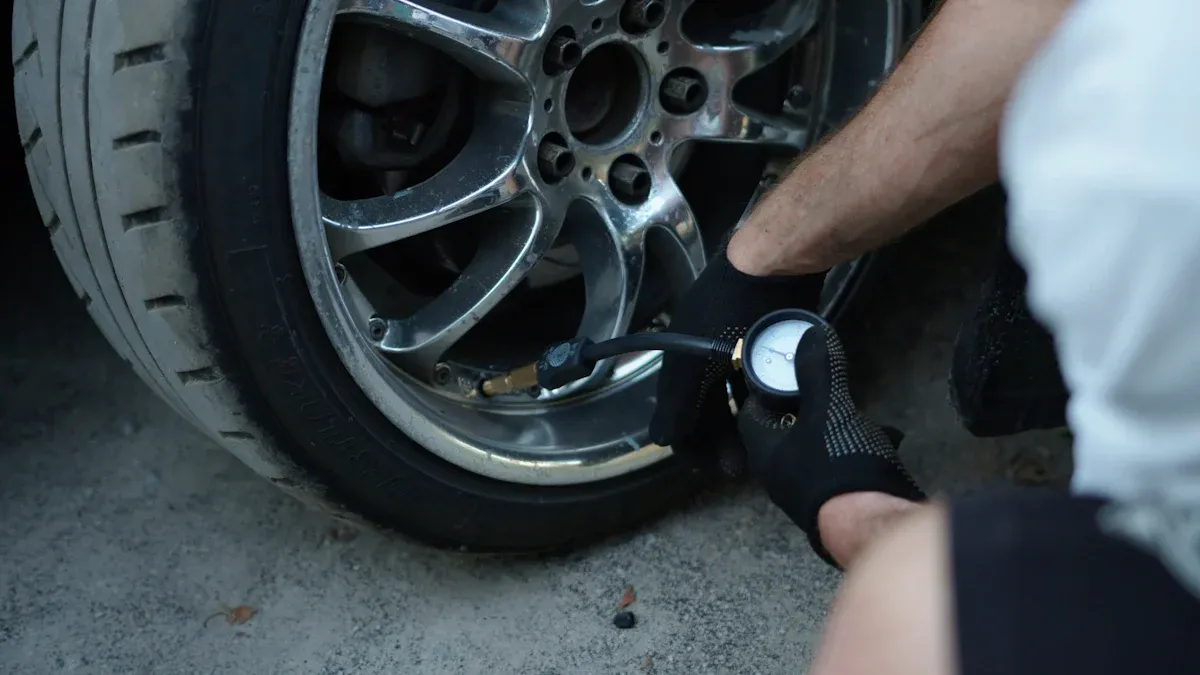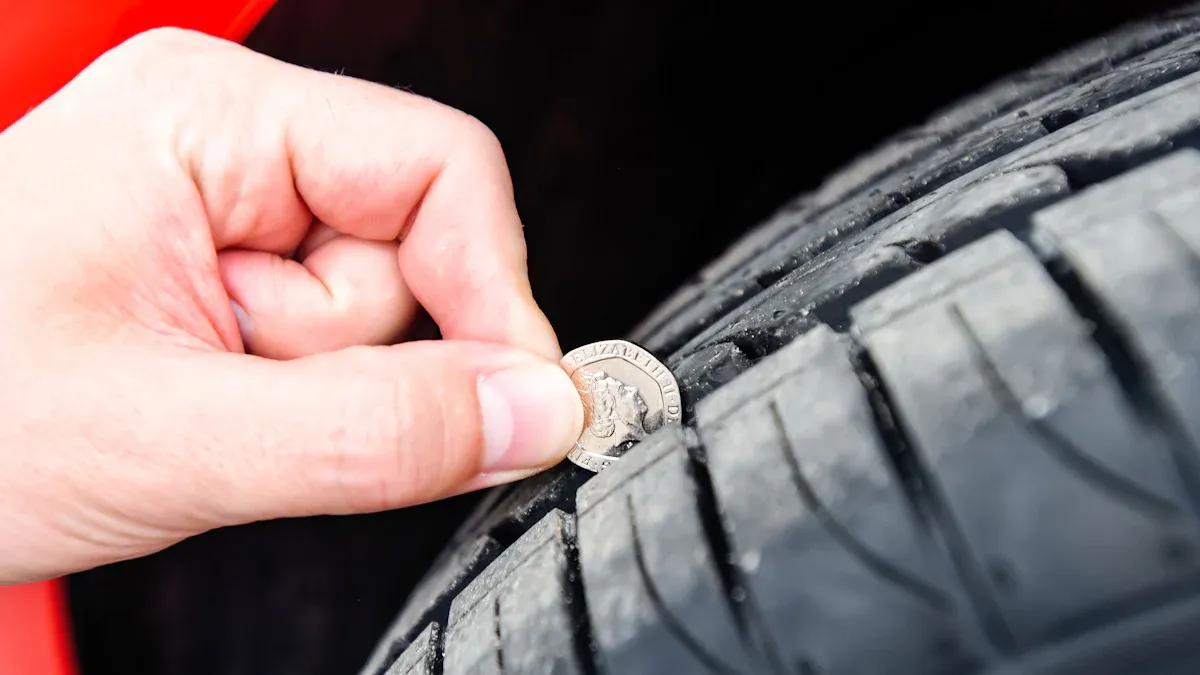
Regularly checking your tire tread depth with a tire tread reader is very important for your safety on the road. Good tread depth helps your tires grip the road, especially when it is wet. This reduces the chance of hydroplaning. In the USA, most states say you need at least 2/32 inches (about 1.6 mm) of tread depth. The same rule is true in Europe. Staying within these limits is key for safe driving.
Főbb tanulságok
Regularly check your tire tread depth to ensure safety on the road. Aim for at least 2/32 inches of tread depth to avoid hydroplaning.
Use the penny or quarter test for quick checks. If you can see the top of Lincoln’s or Washington’s head, consider replacing your tires.
Smartphone apps can provide accurate measurements of tire tread depth. They offer a modern solution with easy-to-read reports.
Method 1: The Penny Test

How to Use a Penny
Using a penny to ellenőrizze a gumiabroncs futófelület mélységét is easy and fast. Here’s how to do it:
Grab a Penny: Take a penny from your pocket or purse.
Position the Penny: Put the penny into the tread grooves of your tire. Make sure Abraham Lincoln’s head is facing down.
Ellenőrizze a láthatóságot: See how much of Lincoln’s head you can see.
If you see the top of Lincoln’s head, your tread depth is too low. You should think about getting new tires.
If part of Lincoln’s head is covered by the tread, your tires are still good.
This method comes from car stories, making it a classic tip among drivers. Its simple way has helped many check their tires without a tire tread reader.
Effectiveness and Limitations
The penny test is a good way to quickly check your tire tread depth. But it has some limits. Here’s what to know:
Quick Estimate: The penny test gives you a fast way to check your tread depth. It’s great for a quick look before a long drive.
Less Precise: While it shows low tread, it isn’t as exact as a professional gauge. For exact numbers, experts say to use a tire tread gauge.
Here’s a quick look at the accuracy levels:
Módszer | Accuracy Level |
|---|---|
Pénzérme teszt | |
Professional Gauge | Exact measurement, highly precise |
Some common mistakes people make with the penny test include:
Not placing the penny right: Make sure Lincoln’s silhouette is facing you and the penny is upside down.
Misunderstanding how much of Lincoln’s head is visible: If you see the top of Lincoln’s head, it means low tread depth, which is very important.
Not knowing why tread depth matters: Not realizing that low tread depth can cause unsafe driving.
Method 2: The Quarter Test

How to Use a Quarter
Using a quarter to ellenőrizze a gumiabroncs futófelület mélységét is easy and works well. Here’s how to do it:
Find a Quarter: Take a quarter from your pocket or wallet.
Insert the Quarter: Put the quarter into the tread grooves of your tire. Make sure George Washington’s head is facing down.
Evaluate Visibility: Look at how much of Washington’s head you can see.
If you see the top of his head, think about getting new tires.
If part of his head is covered by the tread, your tires are still okay.
This method is helpful because it shows when you should replace your tires better than the penny test.
Comparison of Accuracy
A quarter test is usually more accurate than the penny test for checking tire tread depth. Here’s why:
Earlier Detection: The quarter test shows you need new tires at 4/32 hüvelykes küszöbhöz viszonyítja.. This is safer than the penny test, which only warns you at 2/32 of an inch. Finding tread wear early helps you act before it becomes a safety problem.
Improved Safety: Having enough tread depth helps your vehicle handle and stop better, especially in wet weather. This makes the quarter test a smart choice for staying safe on the road.
Here’s a quick comparison of the minimum safe levels for tire replacement:
Tread Depth Indicator | |
|---|---|
Negyed dollár teszt | Less than 4/32″ |
You might want to use the quarter test in certain situations:
If you live where it rains a lot, this method gives you a better idea of tread depth, which is important for safety.
Tire experts suggest the quarter test to help you replace tires before tread depth becomes a safety issue.
To keep your tires in good shape, check your tread depth often. Here’s a quick guide on what to look for:
Futófelület mélysége | Recommendation |
|---|---|
4/32″ or deeper | Jó |
3/32″ | Replace Tires Soon |
2/32″ or less | Replace Tires Now |
By using the quarter test, you can avoid tire problems and stay safe on the road.
Method 3: Tire Wear Bars
Tire wear bars, also known as tread wear indicator bars, are small rubber inserts found in the grooves of your tires. They serve a crucial purpose: they alert you when your tread depth has worn down to a level that requires replacement. Locating these wear bars is simple. Just look for the small, raised sections within the tread grooves. They usually sit lower than the surrounding tread. When the tread wears down to the same level as these bars, it’s time to consider new tires.
Locating the Wear Bars
To find the wear bars, follow these steps:
Inspect the Tread: Look closely at the grooves of your tire.
Identify the Bars: Spot the small rubber strips that run across the tread.
Check Their Height: Compare the height of the wear bars to the surrounding tread. If they’re flush with the tread, it’s a sign you need to replace your tires.
Visual Inspection Checklist
When checking for tread wear, keep an eye out for these common signs:
Reduced tread depth
Excessive wear in the center or edges
Irregular patterns like cupping or feathering
Uneven patches across the tire’s surface
These indicators can help you assess whether your tires are safe for driving. Remember, the minimum tread depth should be no lower than 2/32″. If you see that Lincoln’s head is fully visible in the penny test, it’s time to get new tires. Regularly checking tire wear not only enhances your safety but also improves your vehicle’s performance. So, make it a habit to inspect your tires and stay safe on the road!
Method 4: Ruler or Tape Measure Hack
Measuring your tire tread depth with a ruler or tape measure is a straightforward method that can give you a more accurate reading than the penny or quarter tests. Here’s how to do it:
How to Measure Tread Depth
Gather Your Tools: Grab a ruler or a tape measure. Make sure it has a clear scale for easy reading.
Find the Right Spot: Look for the deepest groove in your tire tread. This is where you’ll measure.
Insert the Ruler: Place the ruler or tape measure into the groove. Make sure it goes all the way down to the bottom.
Olvassa le a mérőeszköz mérését: Check the depth against the scale. For accuracy, use the 1/16” scale, as this is equivalent to 2/32”.
Remember, checking the tread depth at multiple points around the tire gives you a better overall picture of tread wear.
Safety Considerations
When you measure tire tread depth, keep these safety tips in mind:
Always ensure your vehicle is parked on a flat surface.
Use caution when working around tires. They can be heavy and may roll.
If you’re unsure about your measurements, consider using a tire tread reader for more precise results.
By following these steps and precautions, you can effectively measure tire tread depth and ensure your tires are safe for the road. Regular checks help you stay ahead of potential issues and maintain optimal performance.
Method 5: Smartphone Apps and Camera
Smartphone apps can help you check your gumi futófelület mélységéről easily and accurately. Many apps use your phone’s camera to measure how worn your tires are. This gives you a modern way to solve an old problem. Here are some of the best free apps you can try:
Top Free Apps
App Name | Leírás | Rating |
|---|---|---|
Futófelület mélysége | This app checks tire tread depth and saves tire details. | |
TireScan Advisor | It uses AI to check tire condition and measure tread depth with pictures. | 3.5 out of 5 |
These apps are easy to use, making it simple for you to track your tire health.
Using Your Camera Effectively
To get the best results from your smartphone, follow these steps:
Download an App: Pick one of the suggested apps and install it on your phone.
Prepare Your Tire: Make sure your tire is clean and dry. Dirt can change the measurement.
Position Your Phone: Hold your phone right above the tread. Make sure the camera focuses on the tread grooves.
Follow the App Instructions: Most apps will guide you through the steps. They may ask you to take a few pictures from different angles.
Review the Results: After taking the photos, the app will check them and give you a report on your tire tread depth.
Using smartphone apps has many benefits over traditional methods. For example, they provide AI-powered accuracy to 1/32 inch, which is better than manual measurements. Plus, they create easy-to-read reports, lowering the chance of mistakes.
By using technology, you can stay updated on your tire tread wear and keep safe on the road.
Checking your tire tread depth often keeps you safe while driving. It helps avoid accidents and makes your car work better. Think about getting a laser tread gauge for exact measurements. This tool can help you feel secure and make sure your tires are in great condition! 🚗✨
GYIK
Milyen gyakran kell ellenőriznem a gumiabroncs futófelület mélységét?
You should check your tire tread depth at least once a month or before long trips.
Mi történik, ha a futófelületi mélység túl alacsony?
Low tread depth increases the risk of hydroplaning and reduces traction, making driving unsafe.
Can I use other coins besides pennies and quarters?
Yes, you can use any coin, but pennies and quarters are the most common for quick checks.
Lásd még
A gumiabroncs futófelület mélységmérőinek elsajátítása a pontos mérésekhez
A gumiabroncs futófelület mélységének ellenőrzésének fontossága a biztonság érdekében
Az intelligens gumiabroncs futófelület mélységérzékelőinek megértése és azok működése






